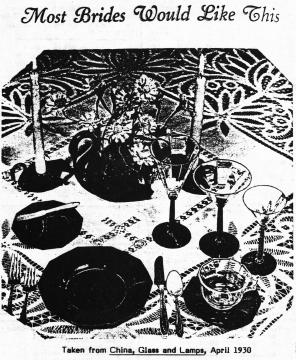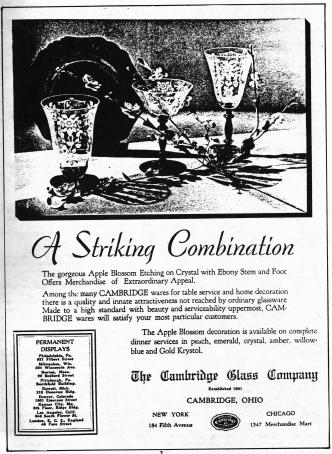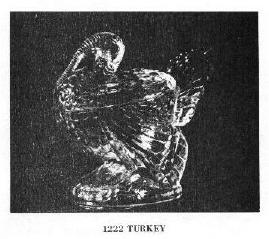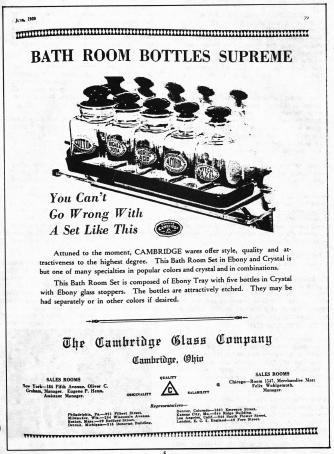Transparent Colors, Part V
by Mark A. Nye
Issue No. 191 - March 1989
As the 1920s drew to a close and the 1930s began, black glass was enjoying a wave of popularity and we find it prominently featured in Cambridge advertising (China, Glass and Lamps, November 1929).
"EBONY AND CRYSTAL IS SMART"
"Not only is the combination of Ebony and Crystal smart and timely, but CAMBRIDGE shapes give it greater attractiveness and sales value.
Always in stem with what is new, CAMBRIDGE wares score heavily because the shapes are distinctive. All in all, a great line in any department store. Try Ebony and Crystal and be convinced.
Illustrated are the No. 3140 sherbet with Crystal bowl and Ebony foot and stem; the No. 3140 Footed Tumbler with Crystal bowl and Ebony foot and stem, and the No. 1176 salad plate in Ebony. Many other items are available in Ebony and Ebony and Crystal"
Throughout 1930 Cambridge advertisements continued to promote the colors of peach-blo, emerald, willow blue, amber, crystal, gold krystol and ebony. Not all ads contained every color since some lines or items were not made in all the Cambridge colors, or at least were not being made in every color at the time the ad was published. In some instances, the text would say "made in all colors" but would only provide a partial list. For instance, the following text accompanied an illustration of a swan being used as a flower holder.
"The artistic Swan line of the Cambridge Glass Co. still continues to gain favor. Made in various sizes and useful in many ways, not only for formal affairs but for every day as well, it is a splendid number for the hot weather months. It is to be had in all the Cambridge colors including peach, emerald, crystal and ebony and is on display at their New York showroom, 184 Fifth Avenue."
China, Glass and Lamps, January 1930 carried this description of one use of ebony Swans.
"Black was used by the Cambridge Glass Co. to make a very striking table decoration on display at Wanamaker's too. This takes the form of a large swan, and you can imagine how effective it would be filled with red flowers, and placed on a mirrored surface in the middle of the table. Black glass candlesticks to match are placed at either side of the swan, and there is a whole - shall I say flock or brood or covey? - of little swans, each of them a salt container."
Featured in several 1930 advertisements was the ebony and crystal
combination as used for stemware and other items. Several etchings,
including #742 and Apple Blossom, can be found on stemware that has
crystal bowl with ebony stem and foot.
 Another rather unusual
combination used by Cambridge in a bridge set (four tumblers and
holder) is amber and ebony; the tumblers are in amber and sit on an
ebony holder.
Another rather unusual
combination used by Cambridge in a bridge set (four tumblers and
holder) is amber and ebony; the tumblers are in amber and sit on an
ebony holder.
Another use of Ebony is described in this advertisement. Apparently there was quite a demand for black glass during 1930, as the following dates to April of that year, when it appeared in China, Glass and Lamps.
"MOST BRIDES WOULD LIKE THIS"
For both formal and informal affairs, the combination of black and crystal glass has been featured by many stores and departments. How the combination lends itself to most attractive settings is well shown by the illustration. The ware shown is by the Cambridge Glass Co., of Cambridge Ohio. Their black glass is known as "Ebony." The advertisement is illustrated at right.
The center arrangement is made up of swans in "Ebony" glass with a large swan as a flower holder and smaller swans as candleholders. The flat ware is in "Ebony" glass while the cup is in crystal, contrasting with the black saucer. Crystal bowls in optic design with "Ebony stem and foot are used for the stemware."
In May of the same year, another advertisement described Cambridge ebony as "a shimmering black."
November 1930 saw a full-page advertisement featuring Apple Blossom,
published in China, Glass and Lamps. Illustrated was Apple
 Blossom etched #3130 stemware with crystal bowl, ebony stem and foot,
behind which stood an ebony plate. The text from this advertisement
read in part: "A striking Combination ..." (Advertisement at right)
Blossom etched #3130 stemware with crystal bowl, ebony stem and foot,
behind which stood an ebony plate. The text from this advertisement
read in part: "A striking Combination ..." (Advertisement at right)
Cambridge had not abandoned its other colors, and new items were continually coming forth from the factory. While rarely seen today, rock crystal cuttings were placed on gold krystol blanks as evidenced by this paragraph that appeared in the October 1930 issue of China, Glass and Lamps:
"Cambridge is also showing a new line of flatware and stemware in gold krystol with rock crystal polished cuttings. Such cuttings on gold krystol are a distinct innovation and their high polish give this tint an even greater appearance of true gold."
While offering no new information, the following, published in November 1930, reflects an unknown writer's thoughts about the Cambridge colors and at the same time mentions the return of a predominance of crystal:
"The Cambridge Glass Co.'s exquisite gold krystol while it is indisputable the favorite, is followed closely by another color which seems to belong naturally to the fall season, and that is Amber. These two hues, blending so well with the flowers most used as table decorations at this time of year, is outstandingly popular in New York.
Next in line, perhaps, comes the soft peach tint, with pale blue as a possible side partner. And an increasing demand for crystal is becoming more and more noticeable with Cambridge, as with most of the glass companies."
The year 1930 closed with a full page advertisement in China,
 Glass and Lamps featuring the Cambridge turkey, or items #1222 as
it was known at the factory.
Glass and Lamps featuring the Cambridge turkey, or items #1222 as
it was known at the factory.
"A Supreme Novelty"
"Symbolic of the many live, quick-selling novelty glassware items to be found in Cambridge displays is the life-like semblance of this Turkey - a striking container for candy, nuts and sweetmeats.Finely executed, this turkey container is a wonderful novelty for Holiday selling. We are prepared to make immediate shipment. Can be had in Gold Krystol, Peach-blo, Emerald, Amber, Willow-blue and Crystal. It is item No. 1222."
As a precaution, I repeat what I said earlier. An advertisement is simply a snapshot of what was available at the time it was conceived, written and published; or, of what the advertiser was interested in promoting, and does not reflect all of the colors or decorations used in conjunction with a given item or line. You may find the turkey in colors other than those listed, as is the case of the swan line.
To be continued ...

